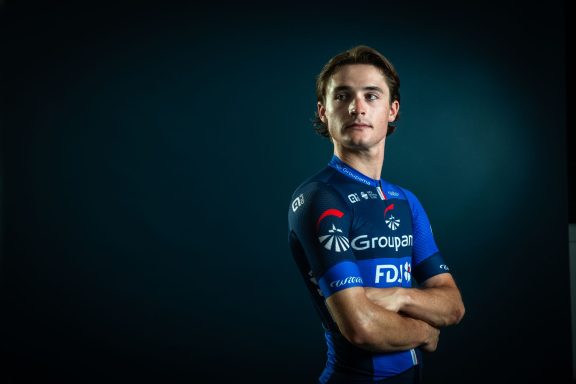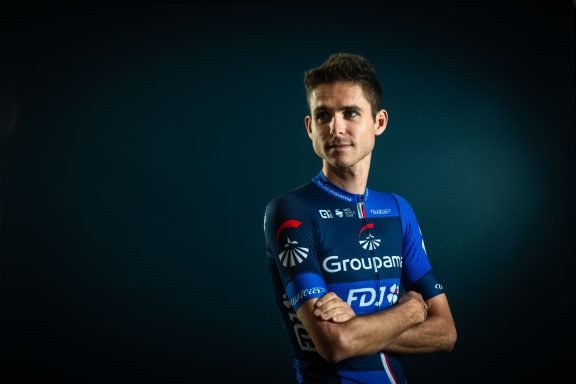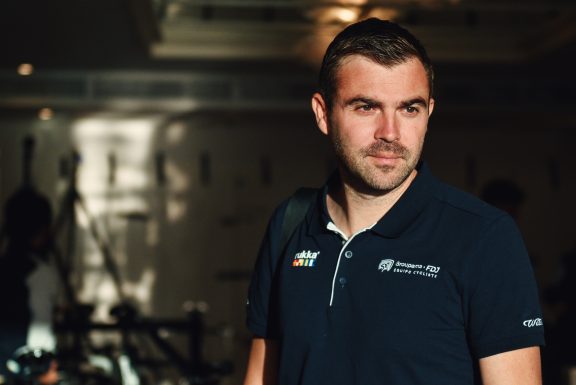Two years after Karl Patrick Lauk, a member of the Conti Groupama-FDJ in 2019, another Estonian has settled down in the team since last winter. Rait Ärm, 20, therefore took part in the memorable past season. The Baltic sprinter is now about to enter the next one, but before he does, we sat down with him to get to know him.
For Rait Ärm, everything started in the small village of Saku, not far from the capital Tallinn and the northern shores of the Baltic Sea. Renowned throughout the country for its beer, the locality did not generate such enthusiasm regarding its cycling club. Back then, its members could be counted on the fingers on one hand. However, after practising sports dancing for several years, Rait was convinced by an initiation training conducted by this very club. “I was nine years old,” he says. “They invited kids from school to try cycling, to discover the sport. I went to try it out, and I really liked it. I found myself with a few friends in this club, and that’s what I liked the most. We had a good time together, we were just doing it for fun.” During the first years, his cycling practice only came down to mountain biking and he did not achieve any particular highlight: “When I was younger, I was not at the top, I don’t remember getting any result at that time”. Although there was not really a sports background in his family, the young boy remained open to other opportunities. So much so that he got to try swimming, basketball or even karate at the same time as he was cycling. Still, like many youngsters, Rait couldn’t miss out on football, the national sport. He was only 15 when he first entered a soccer club, and this time around, cycling was left aside. “I actually stopped training for a year,” he explains. “I really wanted to try football. I did a whole season but it didn’t work out so well, so I got back to cycling a year later and started doing it a little more seriously. “
“I didn’t know much about road cycling”
With his return on the bike comes also a series of novelties. “I got my first road bike when I was 16,” he says. “Until then, I had only ridden on mountain bikes. I also went to Spain for a short training camp. It was my first time ever and it was really exciting. So after that, I started to compete in my first road races, locally and regionally”. From then on, he began a linear progression. It all intensified the following year, while entering the junior category, when his club coach suggested that he join a sports school in Otepää, in the south of the country. “I took his advice, and it turned out to be really good advice,” he says. “It was a real turning point. I was able to start training more, I had more free time next to classes and started to see the results of the training. It wasn’t until my first junior year that I realized I wasn’t that bad at cycling”. In this new environment, he met new playing partners, who sometimes turned into rivals, and continued to improve “step by step”. That year, he achieved his first noteworthy result with a fifth place in the Estonian road championship. This also opened him the doors of the Estonian national team the following year.
Just before celebrating his 18th birthday, he then made his international debut at Ghent-Wevelgem, won by Samuele Manfredi that year. “It was my first race at this level, I wasn’t really good there,” Rait smiles. He actually did not finish the Flandrian Classic, but the experience shed light on his main weaknesses. “I didn’t know how to ride in a peloton, I didn’t know how to position myself, I wasn’t really familiar with slipstream and all that. Basically, I didn’t know much about road cycling at this level”, he analyses. “I was not good in Paris-Roubaix (51st) either, but I then took part in some kermesses in Belgium and I started to have better feelings in the race, to understand how the peloton works, how to move inside it. It had nothing to do with Estonia, where the fields are much smaller”. He also raced in Poland during the spring, and although these various abroad experiences did not bring him significant results, they undoubtedly proved beneficial for the young man. That year, he even won five national medals. Unfortunately, he had to settle for tops-10s on the major road events. On the other hand, his versatility enabled him to climb on the podium in cyclo-cross, mountain biking or even criterium racing. “I got better over the months, but until then I was not thinking of a future in cycling. I was just doing what I loved.”
A European medal and new prospects
It wasn’t until 2019 that something clicked. In his first year U23, Rait Ärm joined the club from Tartu, the second largest city in Estonia, in order to continue his development. He got to race internationally more and more often, with a specific role: that of lead-out man for the team’s captain Norman Vahtra, four year older than him. “I was just going to races and doing what I was asked to do; I was working for our leader and was enjoying cycling. I was also starting to feel stronger and stronger,” he says. His sprinter had a series of victories at the .2 level, and Rait was directly involved in the Grand Prix in Kalmar, in Sweden. He finished in second place, just in his wheel. A week later, Vahtra lined up with the Elite at the European Championships in Alkmaar, which gave his young teammate the chance to step up. In the U23 road race, the 19-year-old’s young man then seized this opportunity head-on. At the end of a tiring race, he turned out to be the big surprise of the event, securing the bronze medal after a powerful sprint almost exclusively done without standing on the pedals. In front of him: Alberto Dainese and Niklas Larsen. Behind him: Stanisław Aniołkowski, Nils Ekhoff or Stefan Bissegger. So to say the crème de la crème of European cycling, while he still was in his first year in the category. He recalls: “Obviously it was a surprise for me too, but it’s true that I approached the race as if I wanted to win it. It was a way to gain confidence. I think that’s the mentality one should have at the start of any race. I had perfect form in this championship, it was a difficult race and it was basically every man for himself. I was the only Estonian rider to make it to the right group and I just kept fighting until the end”.
He actually owed his place on the podium to a few inches only, but that’s how close a destiny can be written. These few centimetres undoubtedly led to all the rest. “At the finish line or on the podium, I didn’t realize what I had accomplished, it was still too early,” he adds. “It wasn’t until the next day that I began to realize how important this result was. It was only at this point that I started to think about a professional career. Before, I couldn’t dare. From that moment on, I realized that I could do things in cycling, and that it was worth a try.” It clicked, finally. However, probably due to his light record at the time, Rait Ärm did not receive so much attention, and his only notifications came from French amateur teams. In winter 2019-2020, he therefore preferred to join a newly created Estonian team: Tartu2024-BalticChainCycling.com, directed by Rene Mandri and Jan Kirsipuu. “It was the best option for me,” he says. “I had the opportunity to be a leader there, we had a good program and it was also a continental team. So it was not bad. The team’s goal was also to take me to the next level. Overall, it’s a great team to help young riders from the Baltic countries (Estonia, Latvia, Lithuania), and also from Finland, to develop and try to make their way through. It is better to join this team at first rather than going to a French amateur club where it could be hard mentally”.
“The Conti is the best thing that has happened to me in cycling so far”
He was naturally more expected in 2020, but the season was however stopped due to the Covid-19 pandemic. Rait Ärm barely had time to score a top-10 in Croatia and, like the rest of the peloton, returned home for several weeks. Nevertheless, thanks to certain flexibility in his country, he could continue to compete in a few local races, to train freely, and therefore maintained “both good mental state and good physical shape”. When the races resumed in the summer, the Estonian performed well straight away. He finished fifth in Poland, secured the silver medal in his national time trial championship but, above all, captured his first UCI victory in the Baltic Chain Tour. On a stage going through his sports school’s city, where everything started, he eventually raised his arms a stone’s throw from the Latvian border. “The emotion was overwhelming at the finish,” he says soberly. He took third place the next day, earning him a place on the final podium of the region’s most prestigious event. Although he could not repeat his previous performance at the European Championship, in Plouay, he still confirmed his ability to shine among the best U23 riders during the Orlen Nations Grand Prix, a Nations Cup event where he took third on a stage. “I didn’t feel like I had to prove anything, I just went for it, like any other race, racing for the win,” Rait adds. “In the end, it was not a bad season at all, despite the Covid”.
As a result of his very decent season, contacts were made with the “Conti” Groupama-FDJ and an agreement was quickly found for 2021. The young man would then stay at the continental level, but would surely step up in the cycling world. “I talked about it with my former coaches and they all told me to go for it,” he recalls. “So I joined the team and I think that’s the best thing that has happened to me in cycling so far”. For the Baltic rider, the change was pretty clear as from the first gatherings. “At first, everything seemed so different. The team was so much bigger and so much more professional than any I had known before. I wouldn’t say it was a shock, just that it was great. I felt like a professional rider”. The welcome from the staff and the riders made his acclimatization both to the structure and to his host city, Besançon, very smooth. “I love the profile of the area,” he also says. “In Estonia, it’s totally flat. In Besançon, I can choose a terrain depending on what I want to work on. It’s perfect!” After a good preparation with his new colleagues, Rait Ärm scored the first remarkable result of the season for the Conti in early March. He took tenth place in a bunch sprint at the Grand Prix Monseré and thus offered the French team the first top-10 in its short history in a class 1 event. “I was really happy with this top-10, but I could have done much better”, he says. “I had the legs for a much better result but it doesn’t always work the way you want it to ”.
Proving in 2022, in the sprints and in the Classics
Yet, the “Conti” was then on his way for what got to be, by far, its best season since its creation. Rait Ärm contributed to it with a handful of top-10s, his Estonian U23 road championship title, but above with his essential work in the lead-out train. “I was always there to support the leaders and do some lead-out,” he says. “It was good, I was getting much and much better race after race. I’m very happy with my national champion’s jersey, I also have a decent sixth place in the Tour de l’Avenir. I’m happy with this season, I could do a lot of work and get better. I’m actually really happy to have been able to play this role, that’s also how you get stronger. I think I needed a season like this. At the end of the day, whether I step on the podium or my teammate does it, it’s the same feeling.” Like most of his teammates, Rait also had the opportunity to race with the big boys. He did it at the very start of the year, at the Bredene Koksijde Classic and Cholet Pays-de-Loire. “I especially noticed that the speed of the peloton was much faster and that the riders were much stronger,” he insists. “It made me realize how hard I needed to train and focus to reach this level. Still, it went ok, I was able to work for the leaders”. In 2022, he would like to be able to achieve major results himself with the Conti. “I hope I have more opportunities to be a leader, to have a train leading me out,” he says. “That being said, I am also ready to work for others as I have done from the start”.
Next March, he will celebrate his 22nd birthday and will also be looking for a contract at the end of the next season. He therefore wants to take advantage of the next months to prove his qualities. “It’s pretty clear that I’m a sprinter,” he adds when defining himself. “I like it when it’s a quick sprint, that suits me, but I’m also performing well after a tough race, with corners and small hills. I don’t necessarily need a flat, straight course. I prefer when it’s a little harder. Therefore, the Belgian Classics could be my thing and they are among my favourite races. There is no hiding in these races. To win there, you have to be very strong. You almost don’t have a chance if you are not one of the best.” Willing to “keep his eye open” to what the great champions do, the Estonian does not have a model in the peloton, however. Not even a youth idol, as he confesses he was not really following pro cycling growing up. A time when he could never imagine himself in his current situation, and was still considering entering the University. “I thought I would continue my studies after high school, then my third place in the European Championship happened,” he concludes. “I decided to postpone University and see what I could do in cycling. I can always go back to University later. I won’t be able to make cycling my job later”.




No comment